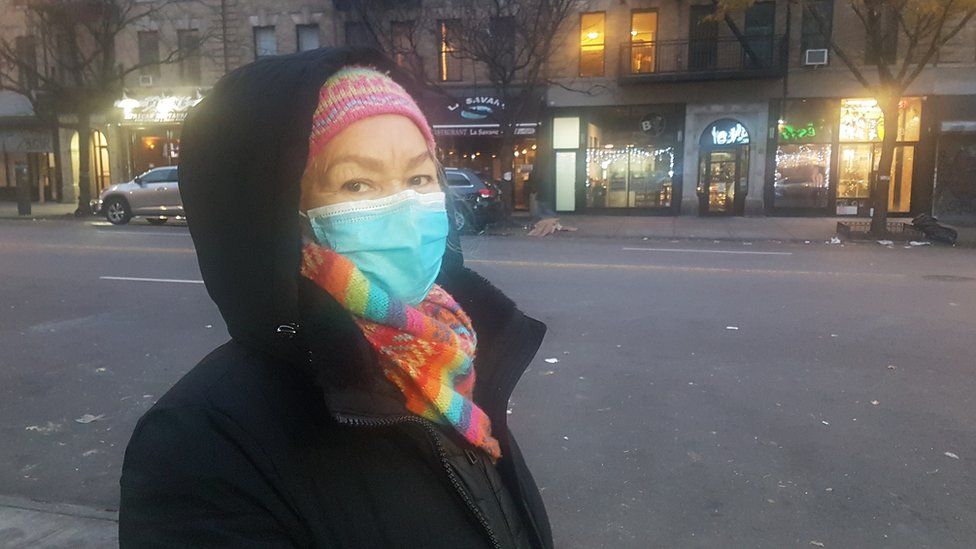
GETTY IMAGES
The consumer price index (CPI) rose 6.8% in the year to November according to the latest figures from the Bureau of Labor Statistics.
Petrol prices jumped 6.1%, while the cost of second-hand cars, rent and food also rose.
However the monthly pace of price rises at 0.8% in November was slightly lower than October’s 0.9%.
Rising inflation is putting pressure on President Biden’s political agenda as he tries to pass his $1.9tn (£1.4tn) social spending bill.
On Thursday, the president made the unusual move of attempting to diffuse the impact of the latest figures ahead of their release, saying the data would not reflect recent declines in the price of energy and used cars.

Shoppers, especially those on low incomes are feeling the pinch of higher prices.
Bibi who works as a cleaner in Harlem, New York, says sometimes she buys one meal, and shares it with her 27 year old son.
“We don’t have any choice,” she says, “I can’t afford to cook.
“I take a little bit then I give him more because a mother is always going to do that for her child.”
Price rises are eating into her shopping bills: “Gas went up when gas goes up everything goes up,” she says.

Patricia, who has just shopped in the local supermarket says her shopping is costing about $30 a week more than it was before, so she’s replacing chicken and pork chops with more vegetables, although prices for fresh produce are also higher she says.
“It affects me a lot right now – I’m not working,” she says.
Maria has just retired and says she’s noticed that what she buys is not only pricier but often smaller too, especially the bagels.
“I’m not going to buy them again for a long time. They used to be big bagels, now they’re smaller and more money,” she says.

Inflation has become a potentially damaging political issue for President Biden. It affects ordinary voters directly. And some economists blame the president’s spending programmes, designed to offer support amid the Covid pandemic, for exacerbating price increases.
“One of the major reasons we have inflation is because the government spent so much money,” said Christopher Campbell, chief strategist at Kroll a risk consultancy, and a former Treasury official under President Trump.
“At the end of the day we hopefully are on the tail end of the pandemic, and the government is still putting its foot on the gas, on the levels of spending.”
However Claudia Sahm, senior fellow at the Jain Family Institute and former Federal Reserve economist says government spending is not the cause. The reason inflation has persisted is because the pandemic has not been brought under control, affecting the supply of cars, fuel and food.
“The longer the Covid-related disruptions last, the more that starts to spread into the prices of goods,” she said.
She says with fuel prices falling in recent days, inflation should start to ease.
“There are signs that we may be turning the corner soon, but Omicron is a new wild card.”
Caleb Thibodeau, at Validus Risk Management said the latest figures would increase both political pressure on President Biden and pressure on the Federal Reserve to act on inflation.
However he said with fuel, shelter and used vehicles making up over half of the 6.8% inflation figure, inflation could start to come down.
“These are factors that could ease quickly, as we have seen recently in oil markets, but remain persistent for the time being,” he said.
Excluding the volatile food and energy components of inflation, the CPI index is 4.9% higher year-on-year, up from 4.6% in October.
Rate expectations
Inflation, triggered by a combination of higher demand from consumers and supply chain problems, was initially expected to fade as pandemic-related disruptions were smoothed out.
But recently both Treasury Secretary Janet Yellen, and Federal Reserve Chair Jerome Powell have said they would no longer refer to inflation as “transitory”.
Speculation is mounting that the Federal Reserve will reduce the bond-buying support it provides every month more quickly than planned, paving the way for a possible rise in interest rates next year.
“The Fed is going to have to move,” said Beth Ann Bovino US Chief Economist, S&P Global ratings
“We expect them to now to speed up tapering and reach zero [monthly support] by March with at least one [interest] rate hike in 2022.”
